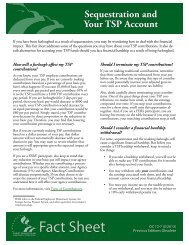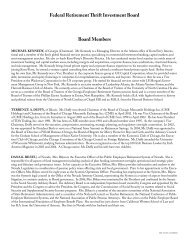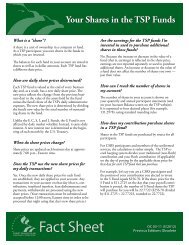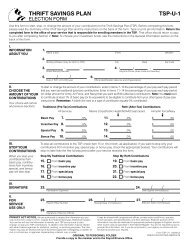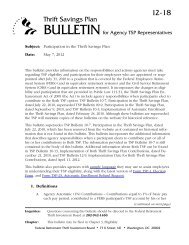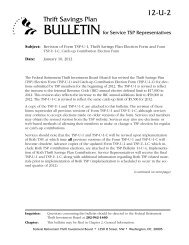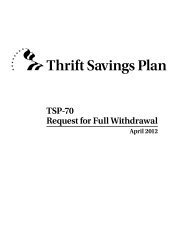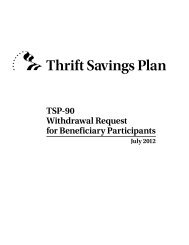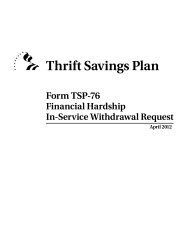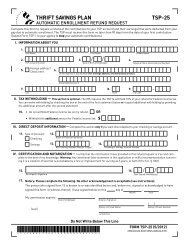PDF, 265 KB - Thrift Savings Plan
PDF, 265 KB - Thrift Savings Plan
PDF, 265 KB - Thrift Savings Plan
You also want an ePaper? Increase the reach of your titles
YUMPU automatically turns print PDFs into web optimized ePapers that Google loves.
Worksheet to Determine Financial Hardship<br />
Use the instructions below to help you complete the worksheet. If you are married, please include financial information for your<br />
spouse.<br />
SECTION I. Calculation for Negative Cash Flow<br />
A. To determine your allowance for ordinary monthly household<br />
expenses, first determine your gross monthly income as<br />
explained in the instructions below and enter that amount on<br />
the line provided. Then, locate your income in the chart on the<br />
right and move across to choose the factor that correlates to<br />
your family size. Enter that factor on the line provided and<br />
multiply it by the amount of your gross monthly income.<br />
Enter the result (rounded to the nearest whole dollar)<br />
on Line A.<br />
B. Enter your monthly scheduled household expenses (see instructions below):<br />
C. Enter your total monthly household expenses by adding Lines A and B:<br />
D. Enter the total net monthly income (see instructions below):<br />
E. Subtract Line D from Line C to determine whether you have a negative cash flow. If Line C is<br />
the same as or less than Line D, you do not have a negative cash flow and should not complete Item F.<br />
F. Multiply Line E by 6 months.<br />
This is the amount you can request due to negative cash flow:<br />
SECTION II. Extraordinary Expenses<br />
G. Total amount of allowed unpaid and unreimbursable medical expenses:<br />
(This is the amount you can request for medical expense reasons.)<br />
H. Total amount due to unpaid and unreimbursable personal casualty loss:<br />
(This is the amount you can request due to personal casualty loss.)<br />
I. Total amount of unpaid and unreimbursable legal expenses for separation or divorce:<br />
(This is the amount you can request to cover your legal expenses due to separation or divorce.)<br />
SECTION III. Maximum Request Amount<br />
J. Add Items F, G, H, and I. (This is the maximum financial hardship withdrawal you can request.)<br />
INFORMATION AND INSTRUCTIONS FOR THE WORKSHEET:<br />
Factor for Family Size of:<br />
Gross Monthly Income 1 or 2 3 or 4 5 or more<br />
Less than $1,250 .85 .90 .90<br />
$1,250 – 1,666 .70 .80 .80<br />
$1,667 – 2,499 .60 .65 .70<br />
$2,500 – 3,332 .50 .55 .60<br />
$3,333 – 4,166 .40 .50 .50<br />
$4,167 – 5,832 .40 .45 .50<br />
$5,833 or more .30 .35 .40<br />
x =<br />
Gross Monthly Income Factor<br />
A<br />
To determine negative cash flow, complete Section I above. If you are requesting a financial hardship for another reason, complete<br />
Section II. Complete both sections if you have a negative cash flow and extraordinary expenses.<br />
• The allowance for ordinary household expenses (Item A) takes into account ordinary monthly recurring expenses (e.g., food, clothing,<br />
household operations, education, health insurance premiums), including expenses frequently charged to credit cards.<br />
If you are in pay status, determine gross monthly income by adding your gross monthly pay and any other monthly income (such as<br />
child support) for you and, if applicable, your spouse. Your gross pay is your pay before taxes and any other deductions are taken out.<br />
If you are in nonpay status, determine your gross monthly income by using your annual salary shown on your earnings and leave<br />
statement. Divide this amount by 12 and then add any other monthly income for you and, if applicable, your spouse.<br />
If any income for you or your spouse is not monthly, you will need to calculate the monthly amount. For example, if you are paid 26<br />
times a year (biweekly), multiply the biweekly amount by 26 and divide by 12.<br />
• Your monthly scheduled household expenses (Item B) include your rent or mortgage, real estate tax, your homeowner’s or renter’s<br />
insurance, and monthly household utilities (if these items are paid separately from your mortgage or rent), dependent care (including<br />
necessary household help due to illness or injury) and any expenses you pay for alimony, maintenance, or child support. You<br />
should also include any installment loan payments other than those related to a TSP loan. Do not include credit cards or charge accounts<br />
or any interest charges on them. These items are considered in your allowance for ordinary monthly household expenses.<br />
• To calculate the net monthly income (Item D) for you and your spouse, add the monthly amounts for Federal, state, and local income<br />
tax withholding, OASDI (Social Security)/Medicare, and monthly Federal retirement deduction (i.e., FERS, CSRS, or uniformed<br />
services). If your spouse has any other type of monthly retirement plan deductions or makes monthly TSP contributions, also add in<br />
those items. Subtract this total from the gross monthly income you provided on Line A and enter the result on Line D.<br />
E<br />
x 6 =<br />
This worksheet is for your records only. Do not submit it with your form.<br />
B<br />
C<br />
D<br />
E<br />
F<br />
G<br />
H<br />
I<br />
J



